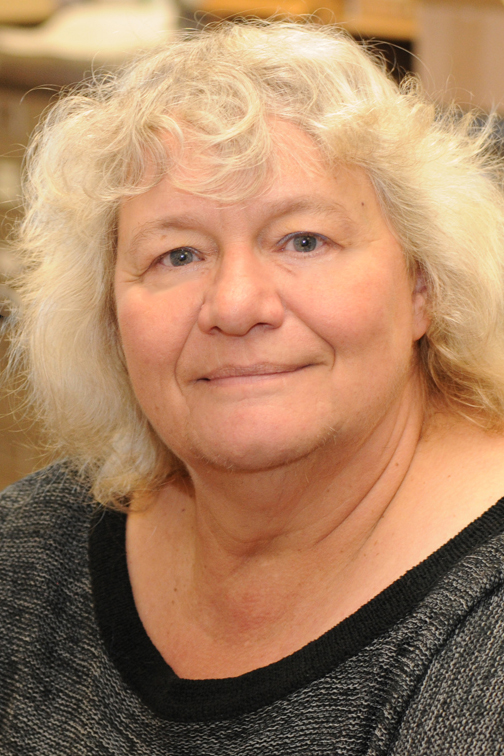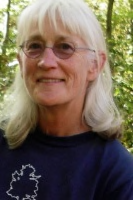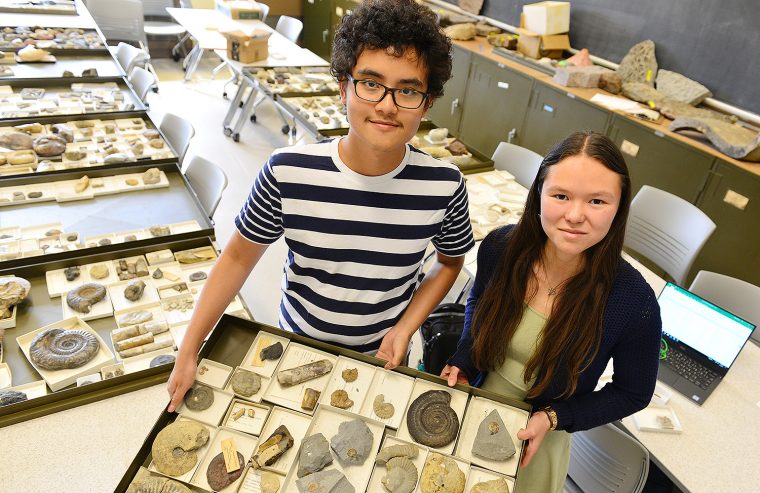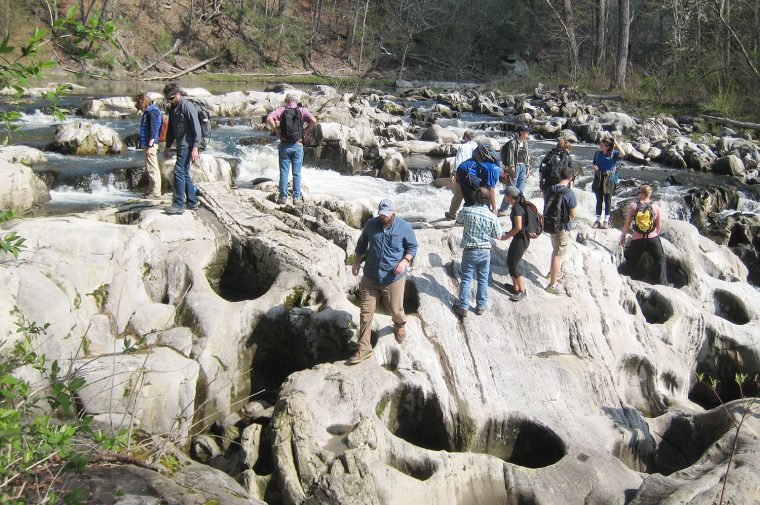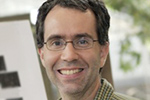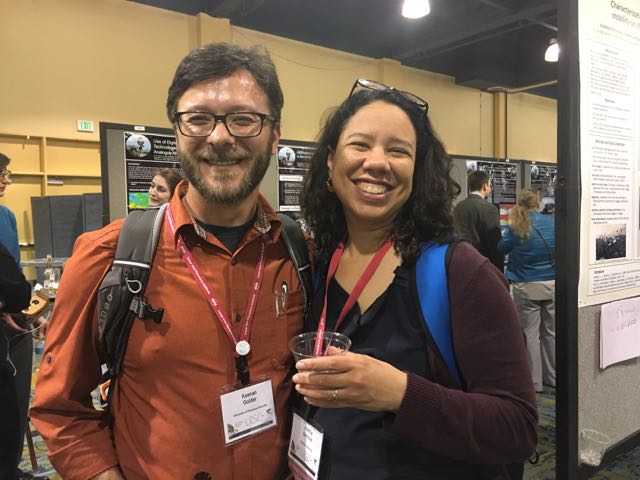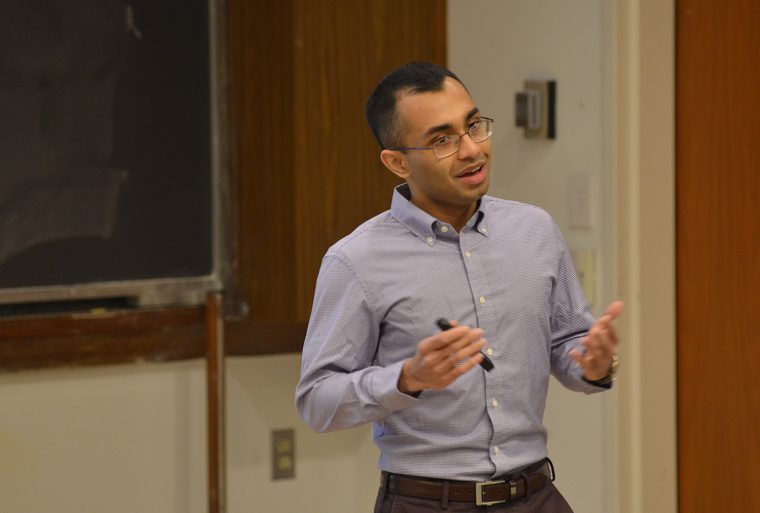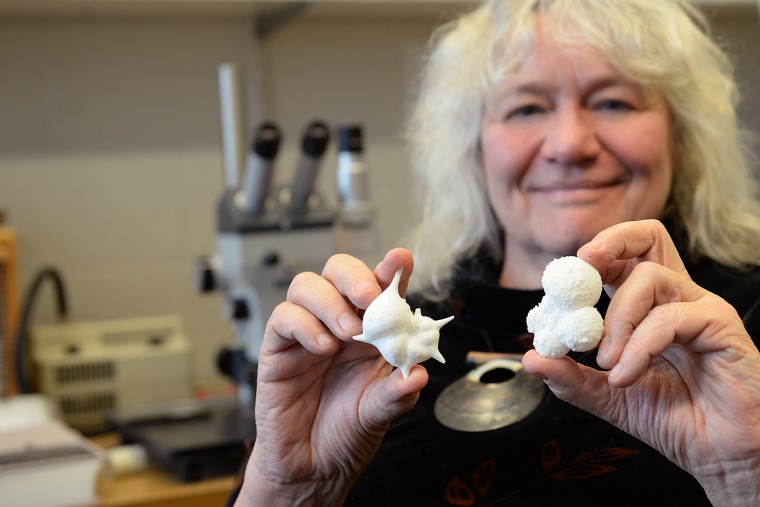Earth and Environmental Sciences faculty and senior seminar students have identified a potentially fast and inexpensive method for collecting and measuring Saharan dust in the Caribbean. E&ES faculty members Dana Royer, Tim Ku, Suzanne O’Connell, and Phil Resor, and students Kylen Moynihan ’17, Carolyn Ariori ’09, Gavin Bodkin ’09, Gabriela Doria MA’09, Katherine Enright ’15, Rémy Hatfield-Gardner ’17, Emma Kravet ’09, C. Miller Nuttle ’09, and Lisa Shepard ’17 have coauthored an article published in the January 2018 issue of Atmospheric Environment. The paper, titled “Tank Bromeliads capture Saharan dust in El Yunque National Forest, Puerto Rico,” summarizes student research…
Students enrolled in the Oceans and Climate service-learning course recently traveled to Washington, D.C., where they had the opportunity to learn how legislation related to climate change is moved through Congress. The trip, held Sept. 25-26, was led by Suzanne O'Connell, professor of earth and environmental sciences, faculty director of the McNair Program. After a day of travel and overnight stay, the group took an early Metro ride to the Library of Congress in Washington, D.C., where they met with representatives of the Congressional Research Service. Later that morning, the class traveled to the Dirksen Senate Building, which houses the U.S. Senate…
Ellen Thomas, University Professor in the College of Integrative Sciences and research professor of earth and environmental sciences, is a co-author of a paper titled "Very Large Release of Mostly Volcanic Carbon During the Paleocene-Eocene Thermal Maximum," published in the weekly science journal Nature on Aug. 31. The study focused on Palaeocene–Eocene Thermal Maximum, a surface warming event associated with ecological disruption that occurred about 56 million years ago, releasing a large amount of carbon. The researchers combined boron and carbon isotope data in an Earth system model and found that the source of carbon was much larger than previously thought. Most…
Suzanne O'Connell, professor of earth and environmental sciences, was named a Councilor of the Geological Society of America for the GSA's governing board. O'Connell will hold this position July 2017 through June 2021 along with two other faculty from the University of Rochester and California State University. "GSA members have again elected thoughtful and innovative individuals to lead the organization and further the impact of geoscience," said GSA Executive Director Vicki McConnell. "I am excited to work with the new Officers and Councilors as they join the GSA leadership team." In addition, Marty Gilmore, the George I. Seney Professor of Geology, professor of earth and environmental…
Scattered throughout campus are remnants of not only Wesleyan's history, but world history. After the closing of the Wesleyan Museum in 1957, thousands of specimens in many collections were displaced, often haphazardly, to nooks, crannies, tunnels, attics, storage rooms, and random cabinets at Exley Science Center, Judd Hall, and the Butterfield and Foss Hill residence complexes. Many of these specimens haven't been accessed in 60 years. "Sadly, few people are aware that Wesleyan has these unique resources," said Ellen Thomas, the University Professor in the College of Integrative Sciences and research professor of earth and environmental sciences. "The collections have not been…
From April 27-30 the Department of Earth and Environmental Sciences hosted the 30th Annual Keck Geology Consortium Symposium at Wesleyan. The event involved several field trips to local sites of geographic significance and concluded with presentations at Exley Science Center from those who attended the field trips. The first trip was led by Paul Olsen, the Arthur D. Storke Memorial Professor of Earth and Environmental Sciences at Columbia University. This excursion examined the Connecticut River Valley Basin for remaining traces of the mass extinction that preceded the rise of the dinosaurs 202 million years ago. "The Connecticut River Valley Basin is one…
Jim Greenwood, assistant professor of earth and environmental sciences, and Bill Herbst, the John Monroe Van Vleck Professor of Astronomy, professor of integrative sciences, have received a research award from NASA in the amount of $550,000 for a program titled “Experimental simulations of chondrule formation by radiative heating of hot planetesimals." The grant will allow Greenwood and Herbst to hire a post-doctoral fellow who will work in Greenwood’s lab in Exley Science Center to reproduce chondrules — small spherules of melted rock that formed early in the history of the solar system and hold clues to the origin of the planets.…
New climate research by Dana Royer, professor and chair of earth and environmental sciences, finds that current carbon dioxide levels are unprecedented in human history and, if they continue on this trajectory "the atmosphere could reach a state unseen in 50 million years" by mid-century, according to an article in Salon. The carbon dioxide levels in the atmosphere today are ones that likely haven’t been reached in 3 million years. But if human activities keep committing carbon dioxide to the atmosphere at current rates, scientists will have to look a lot deeper into the past for a similar period. The…
A group of Wesleyan faculty, students and alumni attended the 48th Lunar and Planetary Science Conference in The Woodland, Texas March 20-24. The annual conference unites 2,000 international specialists in petrology, geochemistry, geophysics, geology and astronomy to present their latest research in planetary science over the course of several days. Professor of Earth and Environmental Sciences and the George I. Seney Professor of Geology Martha Gilmore coordinated Wesleyan's group. While at the event, she presented her work on the oldest rocks on Venus and Mars gully analogues on Earth. A number of her current graduate and undergraduate students attended and several…
On Feb. 8, John Hossain, a MA candidate from the Earth and Environmental Sciences Department, presented a talk on "The Role of Reverse Fault Geometry on Slip Rate Estimates" during the Graduate Speaker Series. Estimates of fault slip rates are an integral part of assessing seismic hazard because they affect estimates of earthquake renewal and moment release rates. For some faults, however, slip rate estimates vary among geodetic studies or between geodetic and geologic investigations. In his talk, Hossain explained why by using a series of numerical models. Graduate Speaker Series events are open to the entire Wesleyan community. (Photos…
For her outstanding efforts in pioneering studies in micropalaeontology and natural history, The Micropalaeontological Society (TMS) awarded Wesleyan's Ellen Thomas with the 2016 Brady Medal. The Brady Medal is TMS's most prestigious honor and is awarded to scientists who have had a major influence on micropalaeontology by means of a substantial body of research. Thomas was honored for "communicating to an extremely broad audience fascinating, impactful and often thought-provoking research" and "academic encouragement of students and peers over the years with [her] generosity of time in a very busy and successful career," noted TMS President F. John Gregory. Thomas, research professor…
Ellen Thomas, research professor of earth and environmental sciences, is the co-author of "Pteropoda (Mollusca, Gastropoda, Thecosomata) from the Paleocene-Eocene Thermal Maximum of the United States Atlantic Coastal Plain," published in Palaeontologia Electronica, Article 19 (3) in October 2016. The Paleocene Epoch lasted 65 to 54.8 million years ago and the Eocene Epoch lasted from 56 to 33.9 million years ago, and was a period of rapid global warming. The response of many organisms to the Paleocene-Eocene Thermal Maximum (PETM) has been documented, but marine mollusks are not known from any deposits of that age. For the first time, Thomas and her…



